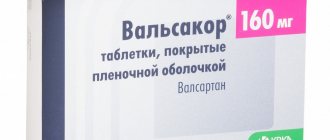Pharmacological properties of the drug Topiramate
Antiepileptic drug of the group of sulfate-substituted monosaccharides. Topiramate reduces the frequency of action potentials characteristic of a neuron in a state of persistent depolarization, which indicates that the blocking effect of topiramate on sodium channels depends on the state of the neuron. Topiramate potentiates the activity of GABA in relation to certain subtypes of GABA receptors (including GABAA receptors), and also modulates the activity of GABAA receptors themselves, prevents kainate from activating the sensitivity of kainate/AMPK receptors to glutamate, and does not affect the activity of N-methyl-D -aspartate in relation to NMDA receptors. After taking the drug orally, topiramate is quickly and effectively absorbed into the gastrointestinal tract. Bioavailability after taking a dose of 100 mg is about 81%. Food intake does not have a clinically significant effect on the bioavailability of topiramate. In healthy volunteers, the average maximum concentration after repeated oral administration of 100 mg 2 times a day is 6.76 mcg/ml. Plasma protein binding is 13–17%. After a single oral dose of up to 1200 mg, the volume of distribution is 0.55–0.8 l/kg; its magnitude depends on gender. In women, the values are approximately 50% of the values observed in men, which is associated with a higher content of adipose tissue in the body of women. After a single oral dose, the pharmacokinetics of topiramate is linear, plasma clearance remains constant at 20–30 ml/min, and AUC in the dose range from 100 to 400 mg increases proportionally to the dose. In patients with normal renal function, it may take 4 to 8 days to reach steady state. About 20% of topiramate is biotransformed to form 6 metabolites, 2 of which largely retain the structure of topiramate and either do not have anticonvulsant activity or exhibit it to a minimal extent. Topiramate and its metabolites are excreted primarily in the urine. After repeated doses of the drug 50 and 100 mg 2 times a day, the half-life averages 21 hours. In patients with impaired renal function (creatinine clearance less than 60 ml/min), the renal and plasma clearance of topiramate is reduced. The time to reach a steady state in patients with moderate or severe renal impairment ranges from 10 to 15 days. In patients with moderate to severe liver dysfunction, plasma clearance is reduced. In elderly people, the plasma clearance of topiramate does not change.
General information about the medicine
Topiramate belongs to the group of antiepileptic (anticonvulsant) medications. It is used in neurology to relieve and prevent convulsive attacks. INN – Topiramate.
Release form, composition, prices
The drug contains the active ingredient topiramate. The medicine is available in the form of tablets for oral administration with different dosages of the active ingredient. Not only the peculiarities of taking the medication depend on this, but also the price of Topiramate.
The approximate cost at which the medicine can be purchased is shown in the table.
| No. | Release form | Dosage (mg) | Number of pieces per package | Approximate price (rubles) |
| 1. | Tablets for oral administration | 100 | 30 | 369 |
| 2. | Tablets (Canon) | 25 | 28 | 284 |
| 3. | Tablets (Canon) | 100 | 28 | 798 |
| 4. | Pills | 25 | 30 | 192 |
All of the above options for Topiramate are produced in Russia, but by different pharmaceutical companies, which is why the price also varies.
Use of the drug Topiramate
When using topiramate as part of combination therapy with other anticonvulsants in adult patients, the minimum effective dose is 200 mg/day. The average daily dose is 200–400 mg, the frequency of administration is 2 times a day. It is recommended to start treatment with a dose of 25–50 mg once a day at night for 1 week. Next, the dose should be increased by 25–50 mg at intervals of 1–2 weeks until an effective dose is selected. The frequency of administration is 2 times a day. If necessary, the daily dose can be increased to a maximum of 1600 mg. The criterion for dose selection is the clinical effect. In some patients, the effect is achieved by taking topiramate once a day. When using topiramate as part of combination therapy with other anticonvulsants in children over 2 years of age, the recommended total daily dose is 5 to 9 mg/kg and is taken in 2 divided doses. Dose selection begins with 25 mg/day (or less, at the rate of 1–3 mg/kg body weight per day), at night for 1 week. Subsequently, at weekly or two-week intervals, the dose can be increased by 1–3 mg/kg, taking the drug in 2 doses. When selecting a dose, one should be guided by the clinical effect. A daily dose of up to 30 mg/kg body weight is usually well tolerated. Topiramate can be taken without regard to meals. When using topiramate as monotherapy, the possible effect of discontinuation of concomitant anticonvulsant therapy on seizure frequency should be considered. In cases where it is undesirable to abruptly discontinue concomitant therapy, the dosage of the drugs is reduced gradually, reducing the dose by 1/3 every 2 weeks. When drugs that are inducers of microsomal liver enzymes are discontinued, plasma concentrations of topiramate will increase. In such situations, if clinically indicated, the dose of topiramate can be reduced. Adults at the beginning of topiramate monotherapy should take 25 mg 1 time per day at bedtime for 1 week. Then the dose is increased at intervals of 1–2 weeks by 25–50 mg/day (the daily dose is divided into 2 doses). If this treatment regimen is intolerant, the dose is increased by a smaller amount or at larger intervals. The dose is selected depending on the clinical effect. The recommended dose is 100 mg per day, the maximum daily dose is 500 mg. In some cases, for monotherapy of treatment-refractory epilepsy, the dose of topiramate may be 1000 mg/day. For children over 2 years of age, with monotherapy in the first week of treatment, topiramate is prescribed at a dose of 0.5–1 mg/kg body weight per day (the daily dose is divided into 2 doses). The dose size and the rate of its increase are determined by the clinical effectiveness and tolerability of therapy. On average, the dose is increased at intervals of 1–2 weeks by 0.5–1 mg/kg/day. The dose range for topiramate monotherapy in children over 2 years of age is 3–6 mg/kg/day. For newly diagnosed partial seizures, the dose may be up to 500 mg/day. The drug is taken 2 times a day. When prescribing the drug to patients with moderate or severely impaired renal function, it should be taken into account that it may take 10–15 days to achieve an equilibrium state in this category of patients, in contrast to 4–8 days in patients with normal function kidney Since topiramate is removed from the blood during hemodialysis, on the days it is performed, an additional dose of the drug should be prescribed, equal to half the daily dose, in 2 doses (before and after the procedure). Topiramate should be discontinued gradually to minimize the possibility of increased seizure frequency. It is recommended to reduce the dose by 100 mg every week.
Release form and composition
The dosage form of Topiramate is film-coated tablets: orange (in a cardboard pack there is 1 jar of 30, 60 or 100 tablets or 1–6 strip packs of 7 or 10 tablets).
Composition of 1 tablet:
- active substance: topiramate – 25 or 100 mg;
- auxiliary components (25/100 mg): magnesium stearate – 0.4/1.6 mg; pregelatinized starch – 23/92 mg; microcrystalline cellulose – 31.4/125.6 mg; aerosil – 0.2/0.8 mg;
- shell (25/100 mg): Opadry II (macrogol – 0.65/2.58 mg; titanium dioxide – 0.23/0.93 mg; polyvinyl alcohol – 1.28/5.12 mg; talc – 0, 47/1.89 mg; aluminum varnish of sunset yellow dye - 0.04/0.16 mg; aluminum varnish of quinoline yellow dye - 0.53/2.1 mg) - 3.2/12.8 mg.
Side effects of the drug Topiramate
Often (especially during dose selection) - ataxia, impaired concentration, confusion, dizziness, fatigue, paresthesia, drowsiness, impaired thinking, rarely - agitation, amnesia, anorexia, aphasia, depression, emotional lability, speech disorders, diplopia, nystagmus, visual impairment, taste perversion; in some cases - increased liver function tests, hepatitis, liver failure (when used simultaneously with other drugs), rarely - nausea, nephrolithiasis, weight loss.
Contraindications
Absolute:
- childbearing age in women who do not use effective contraceptive methods;
- age up to 3, 6 or 18 years (when prescribed simultaneously with AEDs in the treatment of epilepsy, when used as monotherapy for epilepsy or when used for the prevention of migraine, respectively);
- pregnancy and lactation period;
- individual intolerance to the components of the drug.
Relative (Topiramate is prescribed under medical supervision):
- hypercalciuria;
- liver failure;
- renal failure;
- nephrourolithiasis, including aggravated personal or family history.
Special instructions for the use of Topiramate
Adequate and strictly controlled clinical studies of the safety of topiramate during pregnancy have not been conducted, so its use is possible only if the expected benefit to the mother outweighs the potential risk to the fetus. The excretion of topiramate into breast milk has not been studied in controlled studies. A limited number of observations suggest that topiramate is excreted in breast milk. If it is necessary to use topiramate, the issue of stopping breastfeeding should be decided. Topiramate should be discontinued gradually to minimize the possibility of increased seizure frequency. When using topiramate, the risk of kidney stones may increase, especially in patients with a predisposition to nephrolithiasis, as well as when using other drugs that contribute to the development of nephrolithiasis. To reduce the risk of developing nephrolithiasis, you should increase the volume of fluid consumed. If the patient's body weight decreases while taking topiramate, the diet should be adjusted. In patients with impaired liver function, topiramate should be used with caution due to the possible decrease in clearance of this drug. Patients taking topiramate should avoid drinking alcohol. Topiramate should not be used in children under 2 years of age. Topiramate should be prescribed with caution to patients engaged in potentially hazardous activities that require increased attention and speed of psychomotor reactions, since its use may cause drowsiness and dizziness.
Overdose
The main symptoms and signs of overdose: arterial hypotension, metabolic acidosis, speech/vision disorders, drowsiness, convulsions, diplopia, dizziness, stupor, lethargy, impaired thinking/coordination, abdominal pain, depression, agitation. The clinical consequences of overdose are usually not severe, but deaths have been reported after using a mixture of several drugs, including Topiramate.
There is no specific antidote. If necessary, symptomatic treatment is indicated. You should immediately rinse the stomach, induce vomiting, and increase water consumption. Activated carbon can be taken. The most effective way to remove topiramate from the body is hemodialysis.
Drug interactions Topiramate
When used simultaneously with carbamazepine, valproic acid, phenobarbital, primidone, topiramate does not affect the value of their equilibrium concentrations in the blood plasma. Concomitant use of topiramate has in some cases resulted in increased phenytoin concentrations. Phenytoin and carbamazepine, when used simultaneously, reduce the concentration of topiramate in the blood plasma. With simultaneous use, valproic acid does not affect the concentration of topiramate in the blood plasma. With simultaneous use of a single dose of topiramate, the AUC of digoxin decreased by 12%. When oral contraceptives containing norethindrone and ethinyl estradiol were used concomitantly with topiramate, topiramate did not have a significant effect on the clearance of norethindrone, but the plasma clearance of the estrogen component increased significantly. Thus, when taking topiramate concomitantly with oral contraceptives, their effectiveness may be reduced. When taking metformin and topiramate together, the average maximum concentration and AUC of metformin increase by 18 and 25%, respectively, while the average clearance decreases by 20%, while plasma clearance of topiramate is reduced. The clinical significance of this interaction has not been established. When topiramate is used concomitantly with drugs that predispose to nephrolithiasis, the risk of kidney stones may increase.




